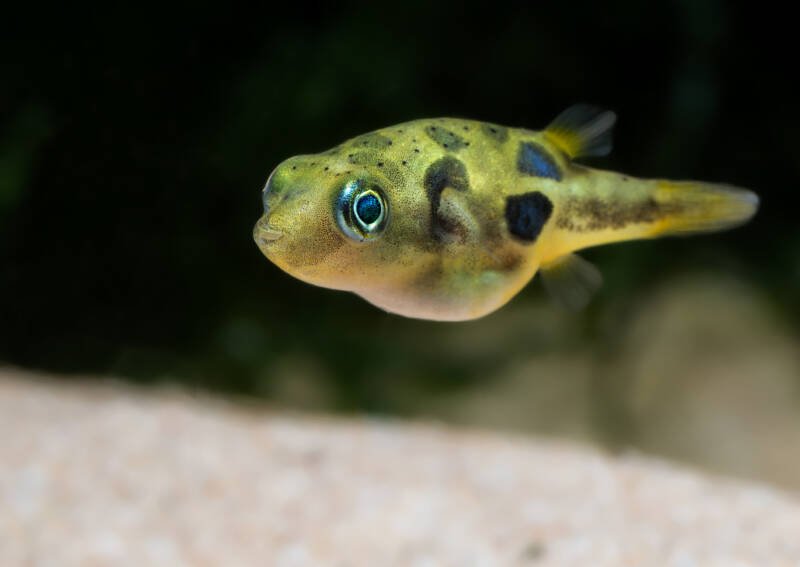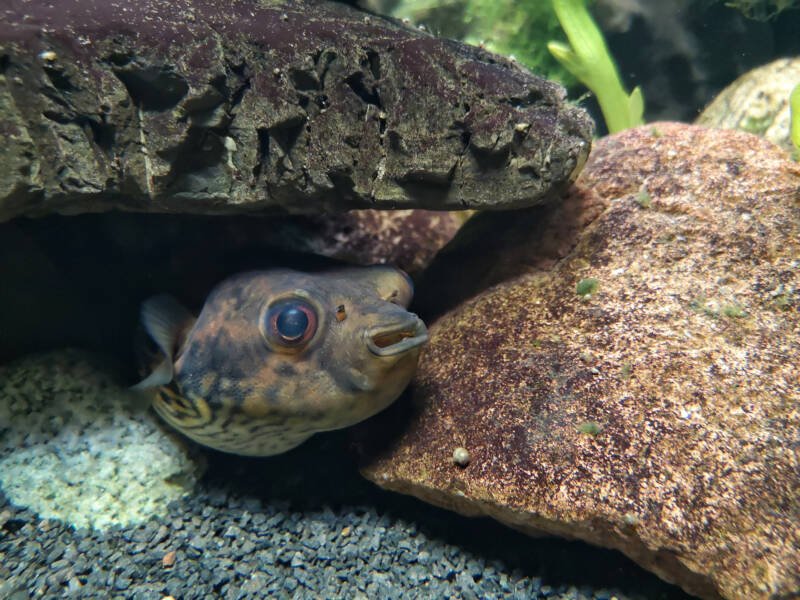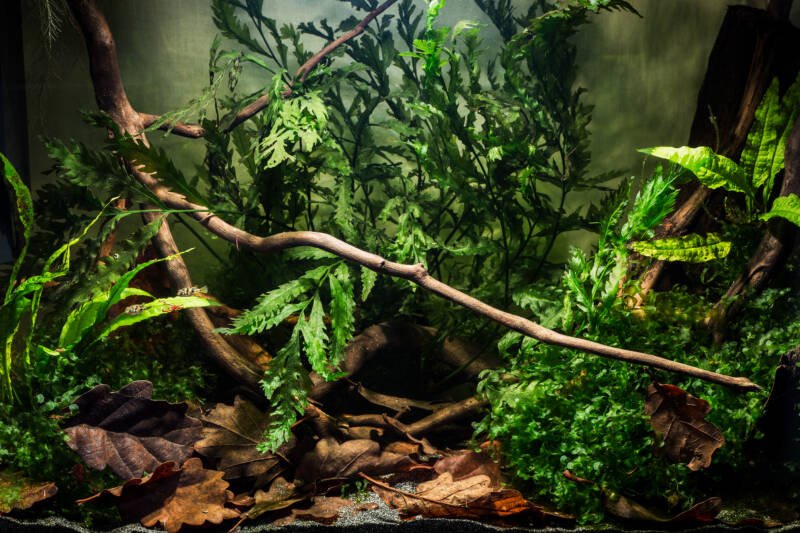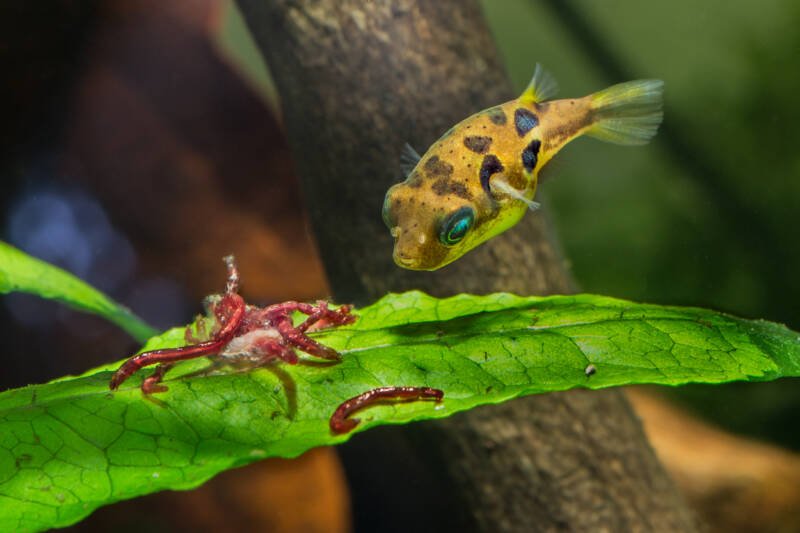Aquarists looking for genuinely unique fish often gravitate towards pea puffers (Carinotetraodon travancoricus).
These tiny members of the puffer family may suffer from a bit of a Napoleon Complex, but they also pack a lot of personality into their rounded bodies.

Pea puffers appear in fish stores under a variety of common names: blue line puffers, dwarf puffers, gold-green dwarf puffers, Indian dwarf puffers, Malabar puffers, pygmy puffers, and red-green dwarf puffers.
That’s a lot of names for a fish smaller than your little finger!
While popular additions to nano aquariums, most people recommend novice aquarists hold off on rushing to pick up pea puffers.
Their care isn’t complicated, but their size (and subsequent tank size) presents specific challenges. Hold off until you’re up to the challenge.
At a Glance
| Tank Size: | 10 gallons (45 l) |
| School Size: | can be housed alone; 3 also acceptable |
| Temperature: | 74-82°F (23-28°C) |
| Lifespan: | up to 4 years |
| Size: | up to 1.4 inches (3.5 cm) |
| pH: | 6.5-8.4 |
| Hardness: | 4-10 dH |
| Ammonia: | 0 ppm |
| Nitrite: | 0 ppm |
| Nitrate: | 0 ppm |
In this article
In the Wild
Pea puffers inhabit the river systems of southern India. Specifically, the states of Kerala and Karnataka on the western coast.
Over a dozen rivers in the region appeal to these tiny puffer species – all of them strictly freshwater sources.
Unlike other puffer species, pea puffers have no tolerance for brackish or saltwater.
They’re freshwater fish, gravitating toward heavily planted sections of slow-moving waters. Like many puffers, they don’t have the best swimming ability, so they avoid strong currents.
Unfortunately, many of those regions have seen deforestation and urbanization, prompting habitat loss.
The rising popularity of pea puffers has also led to overfishing in the wild. As such, the species is now listed on the IUCN list as Vulnerable.
Size: Smallest in the World

If you write out the pea puffer’s scientific name – Carinotetraodon travancoricus – it’ll take up more space than the fish itself.
These tiny freshwater puffers rarely grow longer than 0.75 inches (2 cm). In fact, a maximum of 1.4 inches (3.5 cm) is impressive and not often seen.
Lifespan
On average, pea puffers live around four years. Even aquarists that provide the best water conditions, stay on top of their food quality and keep their puffers from battling each other don’t see them live much longer.
Unfortunately, this short lifespan is one of the reasons the species has landed on the IUCN List.
People grow attached to their personable puffers, and the demand increases due to the frequent turnover. Try to look for fish stores that offer captive-bred puffers.
Behavior

Pea puffers are a species of fish that do equally well on their own or in proper groups.
If you want to set up a nano aquarium with a single puffer, it will happily live on its own without a problem.
Single-species puffer tanks also work – provided you set things up correctly. Ideally, you want to have a single male with two (or more) females. All pea puffers get territorial, but males are prone to fighting with one another.
Unfortunately, until pea puffers reach adulthood, they’re tough to sex.
Most aquarists purchase them as juveniles. You may need to resign yourself to either rehoming a spare male or setting up an extra tank as a precaution.
Pea puffers don’t school together, even when they tolerate sharing tank space.
You need to provide sufficient room for each fish to have its own territory. You’ll also need to break up sightlines, so they aren’t continuously getting “in each other’s way.”
Tank Setup
In theory, a single pea puffer CAN tolerate a 5-gallon (19 l) tank. Keep in mind, however, that smaller tanks are more difficult to keep clean. And puffers, being carnivores, produce A LOT of waste. Make sure you’re up to the task.
If you decide to keep multiple puffers, the basic rule is 5 gallons (19 l) for the first fish and 3 gallons (11 l) for each additional puffer.
Three pea puffers do well in a 10-gallon (38 l) tank, which is also reasonably easy to manage – so long as you decorate correctly.
Take it easy with your filter choice. Pea puffers AREN’T strong swimmers. If your outflow is too strong, they’ll spend their lives fighting against the current.
Sponge filters allow you to set the strength, which is probably your best bet.
Water Conditions
Pea puffers come from tropical regions. You need the water temperature to remain at a constant 74-82°F (23-28°C).
Some people try to get away without using heaters, but if the room’s temperature fluctuates too much, you’ll end up stressing your puffers.
While puffers can tolerate pH ranges between 6.5-8.4, their “sweet zone” is around 7.2-7.5.
If you can maintain a stable pH, though, they’ll be happy. Pea puffers don’t like sudden fluctuations in their water. The same goes for that hardness level of 4-10 dH.
If you want to see that four-year lifespan, you need pristine water conditions. Pea puffers are hardy enough to handle some ammonia, nitrite, and nitrate fluctuations, but 0ppm is the ideal. Again, the smaller the tank, the more difficult it gets to hit those numbers.
Decorating the Pea Puffer Tank

Pea puffers crave planted aquariums. Plenty of lush greenery mimics their natural environment, provides pockets of territory for each fish to claim as their own, and assures them there’s proper material available when they want to spawn.
If you’re going for the smaller tank size, additional plants also help absorb extra nitrogenous wastes.

Since puffers WON’T help with algae clean-up, the extra greenery will outcompete potential algae growth and prevent a bloom from showing up.
Pea puffers are carnivores, so you don’t need to worry about them snacking on your plant life. As such, you have plenty of options for tank décor.
Some attractive options that produce long stems and help break up sightlines include:
Pea Puffers in Communities
Despite their small size, pea puffers can get aggressive over their territory.
They have sharp beaks designed to bite through the shells of snails, shrimp, and other invertebrates. And they won’t hesitate to nip at the fins or sides of other fish.
Most aquarists elect to keep their puffers in species-only aquariums to avoid the risk.
However, if you decorate your tank appropriately and select tank mates carefully, it’s possible to put puffers in a community aquarium.
You’ll need to keep an eye out for any wounds on your fish. Once a fish has an injury, separate it to a quarantine tank while it heals. Otherwise, others in the tank will pick at the wound, preventing healing and leading to an early demise.
Tank Mates
Surprising as it may sound, you want to pair your pea puffers with small, fast-moving fish, particularly if they prefer the middle or top of the water column.
The speed advantage will keep these tank mates from falling prey to your pea puffers:
-
- Barbs (rosy, cherry)
- Corydoras
- Danios (zebra, celestial pearl)
- Dwarf cichlids
- Dwarf rainbowfish
- Killifish
- Mollies
- Otocinclus
- Platies
- Rasboras
- Red cherry shrimp
- Tetras.
Incompatible Species
That lack of swimming ability means you need to avoid larger, predatory fish in your community tank.
True, pea puffers have the pufferfish ability to suck in water and increase their size, but you don’t want this to become a habit – it’s too stressful.

You also want to skip fish with long or flowing fins. Your puffers won’t be able to resist taking nibbles out of the fins, which isn’t fair to the other fish.
And as carnivores, you want to cross freshwater shrimp and snails from the list. In fact, skip most of these tank mates:
Diet and Feeding

Pea puffers fall into the category of strict carnivores. Luckily, unlike other puffer species, you don’t have to do any crazy tooth care so long as you feed them well.
Larger species MUST have crunchy foods to grind down their teeth, but pea puffers are exempt from that rule.
Puffers should get a healthy mixture of live and frozen protein sources. You CAN use freeze-dried foods, but rehydrate them for at least 20 minutes first.
Pea puffer favorite foods include:
- Brine shrimp
- Bloodworms
- Blackworms
- Daphnia
- Grindal worms
- Moina
- Whiteworms
- Young ramshorn snails.
Pea puffers take particular interest in you during feeding time.
Once they’ve adjusted to their tank, they’ll head over to the “feeding zone” as soon as you come over to the aquarium. This “begging” behavior often results in overfeeding. Don’t fall for it.
Hand-feeding DOES help your puffers, though. That slow swimming ability makes them poor competitors against faster members of the community.

You can offer them their food in a different spot in the tank to make sure they get their share.
Breeding: Setting the Stage
Once your pea puffers have matured enough to properly sex them, breeding them isn’t terribly difficult.
You may want to set up a separate breeding tank to protect the fry if you have a community tank, though – just to be on the safe side.
Males or Females?
As adults, males develop color changes that make them easier to pick out. Their bellies turn a greenish-gold in shade, they develop a black lateral line, and they start to show black ovals or stripes on their backs or sides. Males are also on the slender side.
In contrast, the female’s belly turns yellow or white with a yellow patch near the throat.
The ovals are much smaller than you see in the male.
And females have a plumper shape, particularly when she’s ready to lay eggs.
Moss is Best
If you set up a separate breeding tank, 5 gallons (19 l) is plenty for a single pair.
Keep the water temperature at a steady 79°F (26°C). And make sure you have lots of greenery available. In particular, put clumps of Java moss around the tank, as it’s the preferred site for puffer eggs.
The male will chase the female in and around the plants. When she’s ready to spawn, SHE’LL lead him into the vegetation to spawn.
They’ll choose one of those moss clumps, and the male will guard the eggs. (You may notice this if you don’t use a separate breeding tank)
Eggs hatch within 48 hours, and the fry survive on their yolk sac for an additional 2-3 days.
You can offer them infusoria or newly-hatched brine shrimp to help support their growth.
Give these tiny puffers a chance to gain some self-sufficiency before adding them to the community.
Health and Disease
Pea puffers lack scales. This makes them susceptible to skin infections.
When water conditions dip below optimum, putting stress on the fish, their immunity also drops, and such diseases have a better chance of gaining hold.
In particular, pea puffers have a greater chance of succumbing to the following when conditions within the tank sink below optimum:
- Ich
- Fish lice
- Fungus.
Unfortunately, you may not notice these problems until they’ve advanced. Due to the pea puffers’ small size and the natural pattern of their skin, it’s easy to overlook these common infections. Invest in a magnifying glass. Or, better yet, stay on top of your water quality.
Water temperature is one of the biggest concerns for puffer health. It isn’t easy to find heaters for nano tanks. Inexperienced aquarists may not realize their pea puffers have grown chilled overnight, and the fish grow ill as a result.
Pea Puffers: Are They for You?
Pea puffers range in price depending on the age at which you purchase them and whether or not they’re captive-bred or wild-caught.
You’ll see them range from $3 – $15. You WILL need to go to a fish store to find them; you won’t find them in chain pet stores.
When you decide to pick up a pea puffer, choose one with a rounded shape.
Narrow, thin fish may have health issues. You should also ask the store owner what they’ve been feeding their pea puffers so you can make a proper diet transition.
An additional pea puffer purchase to consider is a plastic container. Odds are your puffer won’t swell up during transfers, but they may panic in a net. To prevent possible injuries, you should use plastic containers or cups for all movement.
While pea puffers may not take up much room, the specific water quality needs may prompt additional expenses. Make sure you prepare for everything these tiniest of puffer species needs before you hit the fish store.
The Freshwater Pufferfish
Pea puffers may fit in the palm of your hand, but they pack a lot of personality into their minuscule bodies.
You need to make sure you’re prepared for all of their specific needs – particularly that territorial streak. If you’re on board, they’re the perfect little fish.
Have you kept pea puffers? Do you have a single-species tank, or do you keep them in a community aquarium?
Have you successfully bred your puffers?
Let us know your questions and stories here!